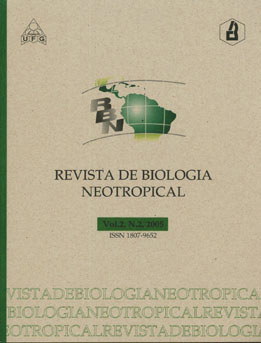Avaliação comparativa dos efeitos tóxico-genéticos da própolis em células somáticas de Drosophila melanogaster, portadoras de diferentes níveis de enzimas de metabolização
DOI:
https://doi.org/10.5216/rbn.v4i1.4658Keywords:
Anticitotóxico, Drosophila melanogaster, mutagênese, própolis, teste SMARTAbstract
This study aimed to evaluate the genotoxic and anti-cytotoxic activities of propolis on mitomycin C (MMC) induced lesions using Drosophila melanogaster strains with different cytochrome P-450 metabolic enzymes expression levels. The wing somatic mutation and recombination test (SMART) was used and supplied a wide spectrum of information concerning genic and cromossomal mutations and/or genetic recombinations. The results indicated that propolis acted as a direct modulator on cytotoxic effects induced by MMC. Furthermore, it was demonstrated that propolis did not induce mutagenic and/or recombinagenic events in D. melanogaster somatic cells. The data showed in this paper corroborates the ones described in the literature, contributing to determine the protective activity of propolis when administrated with genotoxic agents presenting different mechanisms of action.
Downloads
References
Banskota, A. H. Y. Tezuka, J. K. Prasain, K. Matsushige, I. Saiki, & S. Kadota. 1998. Chemical constituents of Brazilian propolis and their cytotoxic activities. J. Nat. Prod. 6: 896-900.
Bazo, A. P., M. A. M. Rodrigues, M. Sforcin, J. L. V. Camargo, L. R. Ribeiro, & D. M. F. Salvadori. 2002. Protective action of propolis in the rat colon carcinogenesis. Teratog. Carcinog. Mutagen. 22: 183-194.
Burdock, G. A. 1998. Review of the biological properties and toxicity of bee propolis (propolis). Food Chem. Toxicol. 36: 347-363.
Clerice, M. T. P. S. 1999. Dermatologia e cosméticos. Revista da Universidade de Franca 7: 20.
Dapkus, J. & D. J. Merell. 1977. Chromosomal analysis of DDT-resistance in a long-term selected population of Drosophila melanogaster. Genetics 87: 685-697.
Frei, H., J. Clements, D. Howe & F. E. Würgler. 1992. The genotoxicity of the anti-cancer drug mitoxantrone in somatic and germ celis of Drosophila melanogaster. Mutat. Res. 279: 21-33.
Frei, H. & F. E. Würgler. 1988. Statistical methods to decide whether mutagenicity test data from Drosophila assays indicate a positive, negative, or inconclusive result. Mutat. Res. 203: 297-308.
Frölich, A. & F. E. Würgler. 1989. New tester strains with improved bioactivation capacity for the Drosophila wing-spot test. Mutat. Res. 216: 179-187.
Fu, J. Y., Y. Xia & Y. Y. Zheng. 2004. Antimutagenicity of propolis against some mutagens in vivo and in vitro. Biomed. Environ. Sci. 17: 469-75.
Garcia-Bellido, A. & J. Dapena. 1974. Induction, detection, and characterization of cell differentiation mutants in Drosophila melanogaster. Molec. Gen. Genet. 128: 117-130.
Garcia-Bellido, A., P. Ripio, G. Morata. 1976. Developmental compartmentalization in the dorsal mesothoracic disco of Drosophila. Dev. Biol. 48: 132-147.
Hällström, I. & A. Blanck. 1985. Genetic regulation of th cytochrome P450 system in Drosophila melanogaster. II. Localization of some genes regulating cytochrome P450 activity. Chem. Biol. Interact. 56: 157-171.
Macedo, S. B. 1999. Uso da própolis em clínica odontológica. Revista da Universidade de Franca 7: 15.
Marcucci, M. C. 1995. Propolis: chemical composition, biological properties and terapeutic activity. Apdologie 26: 83-99.
Mujaili, L. 1999. Uso da própolis na cirurgia plástica. Revista da Universidade de Franca 7: 15.
Moreno, M. I. N., I. C. Zampini, R. M. Ordonez, G. S. Jaime, M. A. Vattuone & M. I. Isla. 2005. Evaluation of the cytotoxicity, genotoxicity, mutagenicity, and antimutagenic- ity of propolis from Tucuman, Argentina. J. Agric. Food Chem. 16: 8957-62.
Orsolic, N., A. B. Saranovic & I. Basic. 2006. Direct and indirect mechanism(s) of anti-tumouractivity of propolis and its polyphenolic compounds. Planta Med. 72: 20-27.
Valadares, B. L. B. 2002. Ação anti-recombinogênica da própolis contra efeitos genotóxicos da doxorrubicina em Drosophila melano- gaster. Dissertação de Mestrado. 83 p. Universidade Federal de Uberlândia, Uberlân- dia, MG.
Downloads
Published
How to Cite
Issue
Section
License
The expontaneos submmition of the manuscript automaticaly implies in the cession of all patrimonial rights for the Journal of Neotropical Bilogy (RBN) after publication. The autor allow the right of first publication of the article to the RBN, under Creative Commons Attribution 4.0 (CC BY-NC 4.0) Licence.
There are garanties for the authors to the authorial and moral rights, for each one of the articles published by RBN, with permissions:
1. The use of article and contents for the education and researches.
2. The use of the article and their contents, linking to the Article on the web site of the RBN, allowing the divulgation on:
- institutional closed web (intranet).
- open access repositories.
3. Preparation and divulgation of the other publication derived from the article and its content, if there is citation of the original publication by RBN.
4. Make printed copies in small quatinties for personal use.

















